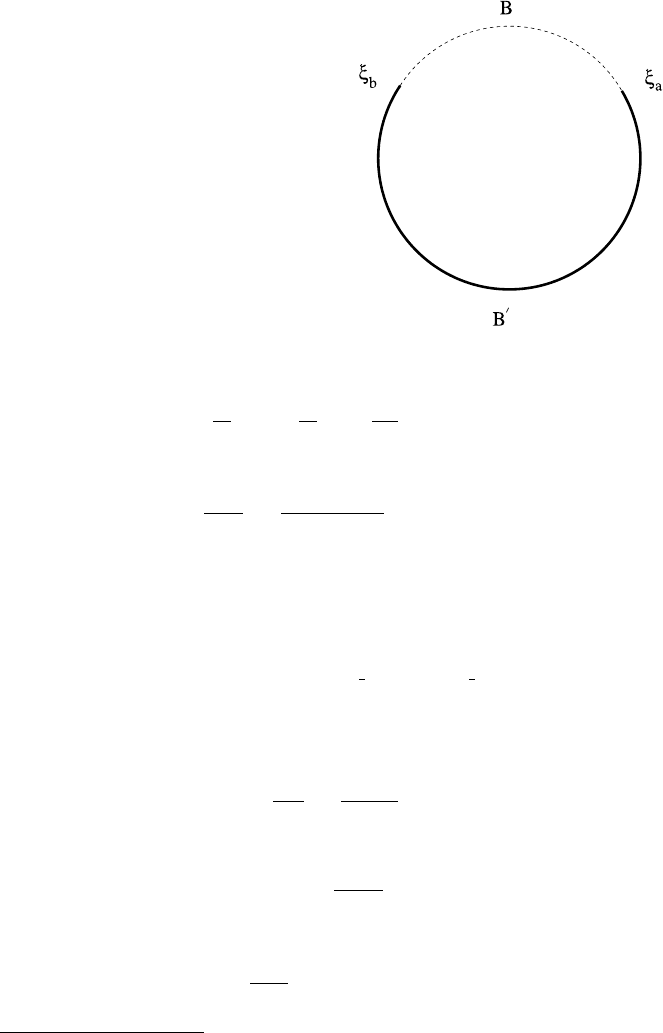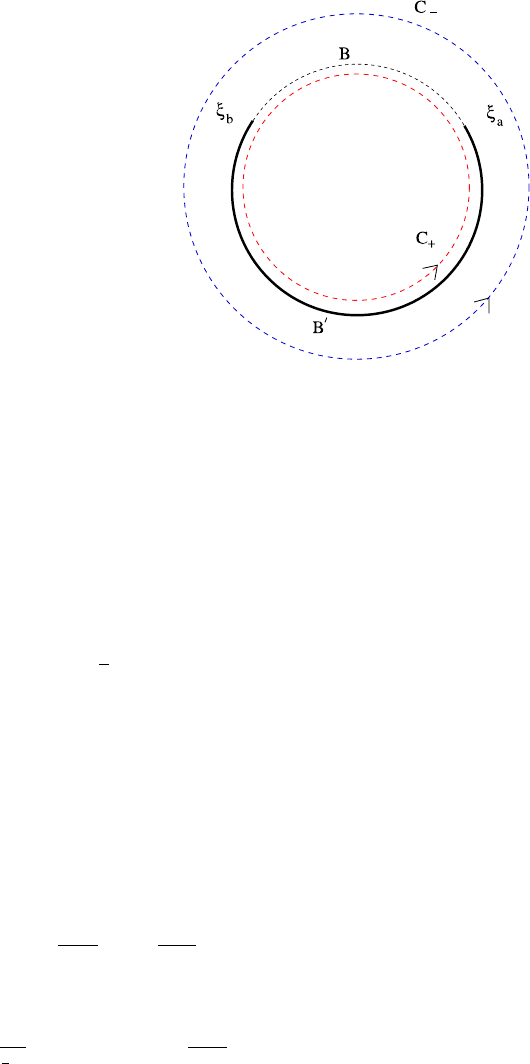Fowler A. Mathematical Geoscience
Подождите немного. Документ загружается.


310 5 Dunes
Separation occurs because the viscous boundary layer (here, the roughness layer)
detaches from the surface, forming a free shear layer at the top of the bubble, which
rapidly thickens to form a more diffuse upper boundary. The assumption of constant
pressure in the bubble is essentially a consequence of this shear layer, implying that
mean fluid velocities in the bubble are small.
For small ε, we can expand the boundary conditions at y = εs about y = 0,
so that to leading order, the problem becomes that of finding an analytic function
f(z)=p +iv in the upper half plane Imz>0, satisfying
f →0asz →∞,
v =s
x
on y =0,
p =p
B
on y =0,x∈B.
(5.228)
The extra pressure condition should help determine s in B, but the endpoint
locations are not necessarily known. Specification of the behaviour of the solution at
the endpoints is necessary to determine these. Firstly, we expect s to be continuous
at the end points:
s(a) =s
0
(a), s(b) =s
0
(b). (5.229)
A difference now arises depending on whether a slip face occurs or not. If not, then
the bed slope is continuous, and at the upstream end point x = a, we might surmise
that boundary layer separation is associated with the skin friction dropping to zero.
Now from (5.174) and (5.176), we have the surface stress defined by
√
τ =1 −εp
0
, (5.230)
where p
0
is the surface pressure. The only apparent interpretation of this which we
can make in our simplified model is to require that
p →+∞ on y =0asx →a−∈B
; (5.231)
more detailed consideration of the boundary layer structure near the separation point
would be necessary to be more precise than this. We do not pursue this possibility
here, mainly because the more relevant situation is when a slip face is present.
If we suppose a slip face is present, then we can presume that separation occurs
at its top, and this determines the point x = a. In addition, it is natural to suppose
that boundary layer detachment occurs smoothly, in the sense that we suppose the
slope of s is continuous at a:
s
(a+) =s
0
(a−); (5.232)
this implies that v is continuous at x =a. If possible, we would like to have smooth
reattachment at b, and in addition (and in fact, because of this) continuity of pressure
also:
[p]
b+
b−
=[p]
a+
a−
=0,s
(b−) =s
0
(b+). (5.233)
We shall in fact find that all these conditions can be satisfied. This is not always
the case in such problems, and sometimes (worse) singularities have to be tolerated.
The choice of the behaviour of the solution at the end points actually constitutes the
most subtle part of solving Hilbert problems.

5.8 Separation at the Wave Crest 311
5.8.1 Formulation of Hilbert Problem
The first thing we do is to analytically continue f(z) into the lower half plane.
Specifically, we define
G(z) =
1
2
[f(z)−p
B
], Im z>0,
−
1
2
[f(¯z) −p
B
], Im z<0.
(5.234)
G is analytic in both the upper and lower half planes, and if G
+
and G
−
denote the
limiting values of G as z →x from above and below, then
G
+
+G
−
=is
,
G
+
−G
−
=p −p
B
,
(5.235)
everywhere on the real axis.
Because of the assumed periodicity in x, we make the following transformations:
ζ =e
iz
,ξ=e
ix
,G(z)=H(ζ). (5.236)
The geometry of the problem is then illustrated in Fig. 5.14. The problem to solve
is identical to (5.235), replacing G by H , and thus we have the standard Hilbert
problem
H
+
−H
−
=0onB,
H
+
+H
−
=iσ
0
on B
,
(5.237)
where σ
0
(ξ) =s
0
(x). We have to solve this subject to the supplementary conditions
H(0) =−
1
2
p
B
,H(∞) =
1
2
p
B
; (5.238)
the first of these in fact implies the second automatically. We seek to apply the
conditions that both
1
2
(p −p
B
) =ReH and
1
2
v =ImH are continuous (thus H is
continuous) at both endpoints ξ =ξ
a
= e
ia
and ξ = ξ
b
= e
ib
.GivenH satisfying
(5.237), then the separation bubble boundary is given by the solution of
s
=−2iH on B, s(a) =s
0
(a), (5.239)
and the pressure on B
is given by
p =p
B
+H
+
−H
−
on B
. (5.240)
Solution
Thesolutionto(5.237), given the location of a and b, is as follows. Define a function
χ(ζ) such that
χ
+
+χ
−
=0onB
(5.241)

312 5 Dunes
Fig. 5.14 B and B
on the
unit circle in the complex ζ
plane. B
is a branch cut for
the solution of the Hilbert
problem (5.237)
(and χ is analytic away from B
); then
H
χ
+
−
H
χ
−
=
iσ
0
χ
+
, (5.242)
and by the discontinuity theorem, we have
H =
χ(ζ)
2πi
B
iσ
0
(t) dt
χ
+
(t)(t −ζ)
+χP, (5.243)
where P is an as yet undetermined polynomial. To find P , we must specify χ, and
this in turn depends on the required singularity structure of the solution.
The smoothness of H is essentially that of χ, and so we will choose the function
χ =
(ζ −ξ
a
)(ζ −ξ
b
)
1/2
. (5.244)
The most general choice is χ =(ζ −ξ
a
)
m
a
+
1
2
(ζ −ξ
b
)
m
b
+
1
2
, where m
a
and m
b
are
integers, but most of these possibilities can in general be eliminated by requirements
either of continuity or at least integrability of the solution.
We consider the behaviour of the Cauchy integral
Φ(ζ) =
1
2πi
B
φ(t)dt
t −ζ
(5.245)
near the end points of integration. Note that in the present case,
φ(t) =
iσ
0
(t)
χ
+
(t)
. (5.246)
First suppose that φ(t) is continuous at an end point.
9
Then we have
Φ(ζ) =±
φ(c)
2πi
ln(ζ −c) +O(1), (5.247)
9
More precisely, φ should be Hölder continuous,thatis,|φ(t
1
) − φ(t
2
)|<K|t
1
−t
2
|
γ
, for some
positive γ .

5.8 Separation at the Wave Crest 313
where c denotes either end point of B
, and the upper and lower signs apply at the
right (ξ
a
) and left (ξ
b
) hand ends of B
, respectively. (5.247) applies as ζ →c, with
ζ/∈B
.
Similarly, for ξ ∈B
,
Φ(ξ) =±
φ(c)
2πi
ln(ξ −c) +O(1), (5.248)
where Φ(ξ) denotes the principal value of the integral (and Φ(ξ) =
1
2
[Φ
+
(ξ) +
Φ
−
(ξ)]).Bearinginmind(5.246), we see that if χ is unbounded at c, and specif-
ically goes algebraically to infinity, then the corresponding Cauchy integral is
bounded, and thus H will be unbounded (unless the choice of P can be chosen
to remove the singularity). Using the definition
H =χ(ζ)
Φ(ζ) +P
, (5.249)
we have from (5.239) and (5.240) that
s
=−2iH(ξ) =−2iχ(ξ)
Φ(ξ) +P
on B,
p −p
B
=2χ
+
(ξ)
Φ(ξ) +P
on B
.
(5.250)
The implication of this is that if χ is unbounded at an end point, then in general both
p and s
will also be unbounded, unless the choice of P removes the singularity. The
worst singularity we can tolerate is an integrable one, thus χ ∼(ζ −c)
−1/2
.
Now suppose that χ is bounded at an end point, and specifically χ ∼(ζ −c)
1/2
.
(Any higher power causes the Cauchy integral to be undefined, because then φ is
not integrable.) If we define
˜
φ via
φ(t) ∼
˜
φ(t)
(t −c)
1/2
as t →c, (5.251)
then
Φ(ζ) =
˜
φ(c)
2(ζ −c)
1/2
+o
1
(ζ −c)
1/2
,ζ∈B,
Φ(ξ) =o
1
(ξ −c)
1/2
,ξ∈B
.
(5.252)
It then follows from (5.250) that s
is bounded (and in fact continuous) and p is
continuous at c. It is because of this that we choose χ as defined in (5.244), in order
to satisfy the smoothness conditions (5.232) and (5.233).
In this case, the polynomial P must be zero in order to satisfy the condition at
ζ =∞, and we have
H =
χ(ζ)
2πi
B
iσ
0
(t) dt
χ
+
(t)(t −ζ)
. (5.253)
We define the integrals
I
0
=
χ
0
2πi
B
iσ
0
(t) dt
tχ
+
(t)
,I
∞
=
1
2πi
B
iσ
0
(t) dt
χ
+
(t)
; (5.254)

314 5 Dunes
we thus have H(0) =I
0
, H(∞) =−I
∞
, and the conditions in (5.238) correspond
to prescribing
I
0
=I
∞
=−
1
2
p
B
. (5.255)
It is a straightforward exercise in contour integration to show that
¯
I
0
= I
∞
, where
the overbar denotes the complex conjugate, therefore (5.255) is tantamount to the
single condition I
0
=−
1
2
p
B
. Because this is a complex-valued integral, (5.255)
actually comprises two conditions for the two unknown quantities p
B
and b.
It remains to be seen whether s is continuous at b. Since (5.255) determines b,
and s is fully determined by (5.239), it is not obvious that this will be the case. (If it
were not, we would have to allow for a singularity in the solution at one of the end
points.)
In fact, it is easy to show that (5.255) automatically implies that s is continuous
at b. To show this, it is sufficient to show that s is continuous over the periodic
domain [0, 2π]. Equivalently, we need to show that
I =
2π
0
s
dx =
B ∪B
−i(H
+
+H
−
)
dξ
iξ
=0, (5.256)
using (5.239) and (5.237). Denoting contours just inside and outside the unit circle
as C
+
and C
−
(see Fig. 5.15), we see that
I =−
C
+
Hdξ
ξ
+
C
−
Hdξ
ξ
. (5.257)
H is analytic inside and outside the unit circle. The integral over C
+
is thus just
2πiH(0) using the residue theorem, while the integral over C
−
can be extended
by deforming the contour out to infinity, whence we obtain the integral 2πiH(∞).
Thus
I =−2πi[I
0
−I
∞
]=0, (5.258)
and continuity of s at b is ensured. We have thus obtained a solution in which the
separated streamline leaves and rejoins the surface smoothly, and the pressure is
continuous at the end points.
5.8.2 Calculation of the Free Boundary
In order to solve (5.239)fors, we need to evaluate H on B
. There are various ways
to do this. One simple one, which may be convenient for subsequent evolution of the
bed using spectral methods, is to use a Fourier series representation. Let us suppose
that
s(x) =
∞
k=−∞
a
k
e
ikx
, (5.259)

5.8 Separation at the Wave Crest 315
Fig. 5.15 The contours C
+
and C
−
lie just inside and
outside the unit circle,
respectively
so that
iσ
0
(ξ) =
∞
k=−∞
d
k
ξ
k
, (5.260)
where
d
k
=−ka
k
. (5.261)
We suppose that the Laurent expansion for iσ
0
extends to the complex plane as an
analytic function with singularities only at 0 and ∞. (This is automatically true for
any finite such series.) Then we can write the solution for H as
H =
1
2
iσ
0
(ζ ) −q(ζ)χ(ζ)
, (5.262)
where q has a Laurent expansion
q =
∞
k=−∞
l
k
ζ
k
. (5.263)
Then we obtain s by solving
s
=s
0
+iqχ (5.264)
on [a,b], with s(a) =s
0
(a). In practice, we would obtain b by shooting.
Suppose that
1
χ(ζ)
=
∞
r=0
f
r
ζ
r+1
, |ζ |> 1 (5.265)
(see Question 5.10 for one way to calculate the coefficients); then we can write
H
1
2
χ
=
∞
m=−∞
d
m
ζ
m
∞
r=0
f
r
ζ
r+1
−
∞
j=−∞
l
j
ζ
j
. (5.266)

316 5 Dunes
As ζ →∞, χ ∼ζ and H →
1
2
p
B
; equating coefficients of ζ
j
in (5.266)forj ≥0
yields
l
j
=
∞
r=0
d
j+r+1
f
r
,j≥0, (5.267)
and for j =0wehave
p
B
=
∞
r=0
d
r
f
r
−l
−1
. (5.268)
For |ζ |< 1, we find
1
χ(ζ)
=
1
χ
0
∞
r=0
¯
f
r
ζ
r
, (5.269)
and thus
H
1
2
χ
=
1
χ
0
∞
r=0
¯
f
r
ζ
r
∞
m=−∞
d
m
ζ
m
−
∞
j=−∞
l
j
ζ
j
. (5.270)
As ζ →0, H →−
1
2
p
B
; equating powers of ζ
j
for j ≤−1, we find
l
j
=
1
χ
0
∞
r=0
¯
f
r
d
j−r
,j≤−1, (5.271)
and for j =0wehave
p
B
χ
0
=
1
χ
0
∞
r=0
¯
f
r
d
−r
−l
0
. (5.272)
Putting these results together, we find that (5.268) and (5.272) together give
(bearing in mind that d
−k
=−
¯
d
k
)
p
B
=
∞
r=0
d
r
f
r
+¯χ
0
∞
r=0
¯
f
r
¯
d
r+1
, (5.273)
with the added constraint that p
B
is real.
We can now use the definitions of l
j
in (5.267) and (5.271) to evaluate iqχ in
(5.264). Being careful with the arguments, we find that on B,
χ =2ξ
1/2
χ
1/2
0
R, (5.274)
where
χ
0
=exp
1
2
(a +b)
,R=
sin
x −a
2
sin
b −x
2
1/2
, (5.275)
and after some algebra, we have the differential equation for s on B:
s
=s
0
−4R Im
χ
1/2
0
∞
j=0
∞
r=0
f
r
d
j+r+1
exp
i
j +
1
2
x
, (5.276)
5.9 Notes and References 317
with initial condition s(a) =s
0
(a). To solve this, guess b; we can then calculate the
right hand side. Solving for s, we adjust b by decreasing it if s reaches s
0
for x<b,
and increase it if s remains >s
0
for all x ≤b.
Computational Approaches
Complex analysis is all very elegant, but is probably not an efficient way to compute
a time-evolving interface. A direct computational approach would be preferable, but
the free boundary nature renders this problematic. Two ways of dealing with this
issue have been suggested, and are discussed further in the notes.
5.9 Notes and References
Books describing sediment transport and its effects on river morphology include
those by Allen (1985), Ahnert (1996), Knighton (1998) and Goudie (1993). Mention
must also be made of Gary Parker’s e-book (Parker 2004), which describes in the
form of powerpoint lectures a wealth of phenomena and theory concerning river
bedforms. The classical book on aeolian dunes is that of Bagnold (1941), and a
more recent classic is that of Pye and Tsoar (1990). Both books have recently been
reprinted, Bagnold’s by Dover in 2005, and Pye and Tsoar’s by Springer in 2009.
Linear Stability The first theory for dune and anti-dune formation which em-
bodied the principle of upstream stress migration was due to Kennedy (1963), as
described in Sect. 5.3. Kennedy was motivated by Benjamin’s earlier (1959) result
on laminar fluid flow over small bumps, but the prescription of a fixed spatial lag is
flawed. Parker (1975) suggested that the inertial effect of bedload (i.e., sediment flux
relaxes to its equilibrium value over a finite length) could be a causative mechanism
for the formation of anti-dunes.
St. Venant-type models were introduced by Reynolds (1965), and the failure of
averaged models to locate instability led Engelund (1970) and Smith (1970) to study
eddy viscosity type models in which the two-dimensional nature of the flow was
paramount. Subsequent developments of the instability theory were made by Fred-
søe (1974), Richards (1980) (who extended the theory to the formation of ripples),
Engelund and Fredsøe (1982), Sumer and Bakioglu (1984), Colombini (2004) and
Charru and Hinch (2006).
Sediment Transport The Shields stress, and the experimental data in Fig. 5.7,
were given in his thesis by Shields (1936). There are a number of empirical es-
timates for fluvial bedload transport, of which that described by Meyer-Peter and
Müller (1948)(seealsoEinstein1950) is a popular one, though possibly not the
best. Similar relations are found for aeolian sand transport (see, e.g., Bagnold 1936;
Pye and Tsoar 1990). Formulae describing the rate of entrainment or erosion of sed-
iments into suspension are given by García and Parker (1991), Van Rijn (1984), and
Smith and McLean (1977), for example.

318 5 Dunes
Turbulent Flow and Eddy Viscosity The use of an eddy viscosity gives the
simplest description for a turbulent flow, but as mentioned in Sect. 5.7.4, the choice
of eddy viscosity is problematic. Prandtl’s mixing-length theory for a shear flow
τ =κ
2
z
2
∂u
∂z
∂u
∂z
(5.277)
correctly yields the logarithmic velocity profile, but is frame dependent, as well
as having an infinite velocity at the wall. Usually (e.g., Schlichting 1979
10
) one
retains the no slip condition by specifying a wall roughness, which has the effect
of applying the no slip condition at a finite elevation z = z
0
. An alternative (and
preferable) method is to include the small laminar viscosity, thus replacing (5.277)
by
τ =
ε +κ
2
z
2
∂u
∂z
∂u
∂z
, (5.278)
in suitably scaled variables; essentially ε =1/Re. Solution of a constant shear stress
shear flow satisfying u =0atz =0 shows that the effective roughness concept can
be applied, where (for (5.278)), we find (see Question 5.11) z
0
=
ε
2κ
.
The frame indifference issue could be resolved by using Von Kármán’s version
of the mixing length, which replaces (5.278) with
τ =
ε +
κ
2
|u
z
|
3
|u
zz
|
2
∂u
∂z
; (5.279)
this is of course also not frame indifferent, but can easily be made so by generalising
to, for example,
τ =2η
˙
ε,
˙
ε =
1
2
∇u +∇u
T
, (5.280)
where the effective viscosity is
η =ε +
2κ
2
|
˙
ε|
3
|∇.
˙
ε|
2
. (5.281)
However, (5.279) is also problematical, because it allows η to depend on the second
derivative of u, thus artificially raising the order of the equations. Taking the mixing
length l =
κ
|u
z
|
does not work. The only other possibility along these lines might be
to assume a dependence on fractional derivatives of u
z
, although there seems little
physical justification for this.
Jackson–Hunt Theory The classic paper describing turbulent flow over a small
hill is that by Jackson and Hunt (1975). Further developments of the theory are
given by Sykes (1980), Hunt et al. (1988) and (less easy to find) Weng et al. (1991).
It is generally acknowledged that the Jackson–Hunt paper is very difficult to read.
10
The Schlichting book went through many reprints, and currently exists in print in a revised
edition by Schlichting and Gersten published by Springer in 2000; this new book is quite different
from the earlier version, and a good deal of material in the original book has been removed.

5.9 Notes and References 319
The theory is complicated for one thing, but the manner of presentation is not
clear. Rather than present a clearly stated boundary value problem, Jackson and
Hunt present solutions, model, approximations, scales and limits all mixed together.
Sykes (1980) provided a more rational asymptotic treatment of the problem, and
pointed out various difficulties in the Jackson–Hunt theory, but like them, Sykes
avoided providing a description for the Reynolds stress until late on. Thus, the
Jackson–Hunt theory divorces the assumed basic logarithmic velocity from the as-
sumed form for the Reynolds stresses. The version of the theory presented here, in
Sect. 5.7.2, adopts a different philosophy: that the logarithmic profile must itself be
a consequence of the boundary value problem to be solved. While this may seem a
sensible approach, it raises the issue of how best to prescribe the Reynolds stresses.
Sykes provides a fairly sophisticated closure scheme, without an indication that the
basic solution has the required logarithmic profile.
Hunt et al. (1988) provide an improved version of the theory, which we sum-
marise here. The paper is again difficult to read. The basal shear stress τ is given by
Eq. (3.1)
H
(all equation numbers with subscripts H refer to Hunt et al. (1988))
τ =ε
2
ρU
2
0
(1 +τ
d
). (5.282)
At the top of page 1,439, we find
ε =
u
∗
U
∞
, (5.283)
where u
∗
is the friction velocity, and U
∞
is the far-field velocity, essentially the
same as our definition in (5.121), whereas U
0
is the velocity of the basic profile
at a height h
m
; however, in Eq. (2.4c)
H
we have ε =
u
∗
U
0
, so we will suppose that
U
0
≈ U
∞
, which is also consistent with the discussion at the very bottom of page
1,438 and the top of page 1,439.
The perturbation shear stress τ
d
is defined in (3.7d)
H
, and using (3.12a,b)
H
its
Fourier transform
11
is given by
ˆτ
d
=−
2p
0
U
2
(l)
σ(k)
1 +δ(2lnk +4γ +1 +iπ)
. (5.284)
p
0
is defined in (2.15)
H
,asisσ , as minus the Hilbert transform of the bed slope.
U(l) is the (scaled, with U
0
in (2.1)
H
) velocity of the undisturbed flow at a height l
above the bed, and is defined (at the bottom of page 1,438) by
U(l) =
ε
κ
ln
l
z
0
, (5.285)
where z
0
is the roughness length; (5.285) assumes l h
m
(as is the case), while l
is defined in (3.6)
H
by
l ln
l
z
0
=2κ
2
d (5.286)
11
Defined, as I have also done here in (5.187), via
...e
−ikx
dx, and denoted by an overhat.
